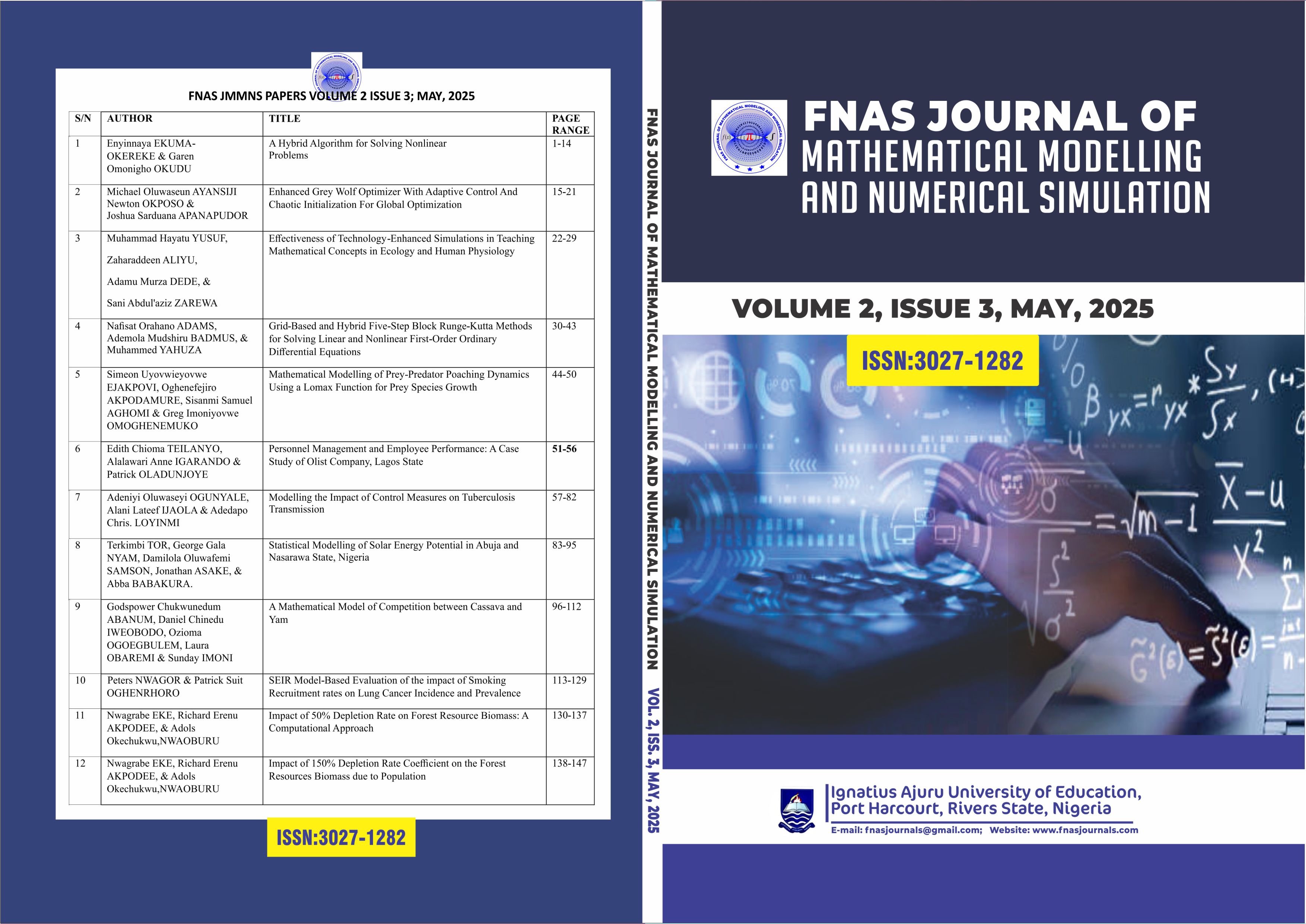SEIR Model-Based Evaluation of the impact of Smoking Recruitment rates on Lung Cancer Incidence and Prevalence
DOI:
https://doi.org/10.63561/jmns.v2i3.869Keywords:
SEIR Model, Intervention Strategy, Disease Mitigation, Cigarette Smoking, Lung CancerAbstract
Lung cancer is one of the leading causes of cancer-related deaths worldwide, with tobacco smoking being the primary risk factor. This study develops an SEIR (Susceptible-Exposed-Infected-Removed) model to investigate the impact of smoking recruitment rates on lung cancer incidence and prevalence. The systems of non-linear ordinary differential equations were used the define the dynamics of Lung cancer, which involves the recruitment rate. The analysis of a total population size in a region N(t) at any time t which is subdivided into five compartments such as, S(t) (susceptible population that is the vulnerable subpopulation who are not infected with lung cancer, but at a high risk of infection as a result of smoking), population who are active smoker ????????( t), population who are victim of smoking Ep ( t), number of individual infected with lung cancer I( t) and number of population recovered from lung cancer R(t) was involved in the study. The positivity, uniqueness and boundedness of solutions were verified, whereas the sensitivity and basic reproductive number were determined analytically. Numerical simulations are performed to explore the effects of varying smoking recruitment rates on lung cancer burden. The results show that reducing smoking recruitment rates can significantly decrease lung cancer incidence and prevalence. Results show that the number of lung cancer cases originating from the active smoker population and higher values of recruitment rate led to increased lung cancer cases among smokers. Increased active smoker recruitment rate (a) leads to higher smoking prevalence, increased lung cancer incidence, and higher mortality rates. Also increased rate of population becoming victim of smoking (b) leads to higher smoking prevalence, increased lung cancer incidence and higher mortality rates. The study recommends implementing advocacy on the Reduction of smoking recruitment rates through education campaigns and promotion of an increase in lung cancer screening and early detection with sound policies to reduce lung cancer incidence rates. The study suggests that enhancing antagonistic relationships between tumour-promoting and suppressive factors could improve the robustness of anti-cancer strategies, making tumours more controllable.
References
Acevedo-Estefania, C. A., Gonzalez, C., Rios-Soto, K. R., Summerville, E. D., Song, B., & Castillo-Chavez, C. (2000). A mathematical model for lung cancer: The effects of second-hand smoke and education (Biometrics Unit Technical Reports No. BU-1525-M). Department of Biometrics, Cornell University.
Andest, J. N. (2013). A mathematical model on cigarette smoking and nicotine in the lung. International Refereed Journal of Engineering and Science, 2(6), 1–3.
Ayinde, K., Lukman, A. F., Rauf, R. I., Alabi, O. O., Okon, C. E., & Ayinde, O. E. (2020). Modeling Nigerian COVID-19 cases: A comparative analysis of models and estimators. Chaos, Solitons & Fractals, 138, 109911. https://doi.org/10.1016/j.chaos.2020.109911 DOI: https://doi.org/10.1016/j.chaos.2020.109911
Beljanski, V., & Hiscott, J. (2012). The use of oncolytic viruses to overcome lung cancer drug resistance. Current Opinion in Virology, 2(5), 629–635. https://doi.org/10.1016/j.coviro.2012.08.007 DOI: https://doi.org/10.1016/j.coviro.2012.07.006
Ekeanyanwu, I. B., Nwagor, P., & George, I. (2025). A binary stability and Monte Carlo simulation analysis of the simultaneous impact of smoking on the dynamics of lung cancer. FNAS Journal of Mathematical Modeling and Numerical Simulation, 2(2), 132–145.
Karthikeyan, K., Karthikeyan, P., Baskonus, H. M., Venkatachalam, K., & Chu, Y.-M. (2021). Almost sectorial operators on Ψ-Hilfer derivative fractional impulsive integro-differential equations. Mathematical Methods in the Applied Sciences. https://doi.org/10.1002/mma.7294 DOI: https://doi.org/10.1002/mma.7954
Nabi, K. N., Abboubakar, H., & Kumar, P. (2020). Forecasting of COVID-19 pandemic: From integer derivatives to fractional derivatives. Chaos, Solitons & Fractals, 141, 110283. https://doi.org/10.1016/j.chaos.2020.110283 DOI: https://doi.org/10.1016/j.chaos.2020.110283
Nwagor, P. (2020). Database prediction of co-existence and the depletion of the viral load of the virions of HIV infection of CD4+ T-cells. International Journal of Applied Science and Mathematics, 7(1), 11–19.
Nwagor, P., & Ekaka-a, E. N. (2017). Deterministic sensitivity of a mathematical modeling of HIV infection with fractional order characterization. International Journal of Pure and Applied Science, 10(1), 84–90.
Nwagor, P., & Lawson-Jack, I. (2020). Stability analysis of the numerical approximation for HIV-infection of CD4+ T-cells mathematical model. International Journal of Research and Innovation in Applied Science, 5(2).
Okeke, I. S., Nwagor, P., Yakubu, H., & Ozioma, O. (2019). Modelling HIV infection of CD4+ T cells using fractional order derivatives. Asian Journal of Mathematics and Applications, Article ID ama0519, 1–6. http://scienceasia.asia
Trisilowati. (2019). Stability analysis and optimal control of lung cancer growth model with education. IOP Conference Series: Materials Science and Engineering, 546, 1–8. https://doi.org/10.1088/1757-899X/546/1/012007 DOI: https://doi.org/10.1088/1757-899X/546/5/052081
Umoh, U. S., & Nwagor, P. (2024). Mathematical modelling approach for sensitivity and stability analyses of cholera disease in aquatic habitat. International Journal of Engineering and Artificial Intelligence, 8(1), 22–36.
Umoh, U. S., & Nwagor, P. (2024). Mathematical modelling approach for uncertainty and sensitivity analyses of cholera infection in an aquatic environment. Journal of Research in Education and Society, 15(2), 81–95.
Wardah, L., Trisilowati, & Kusumawinahyu, W. M. (2017). The effect of smoking behaviour in the human population growth of lung cancer patients. Natural B, 4(2), 117–126. DOI: https://doi.org/10.21776/ub.natural-b.2017.004.02.6
Zhang, Z., Zou, J., & Upadhyay, R. K. (2020). Stability and Hopf bifurcation analysis of a delayed tobacco smoking model containing snuffing class. Advances in Difference Equations, 2020, Article 349. https://doi.org/10.1186/s13662-020-02808-5 DOI: https://doi.org/10.1186/s13662-020-02808-5


